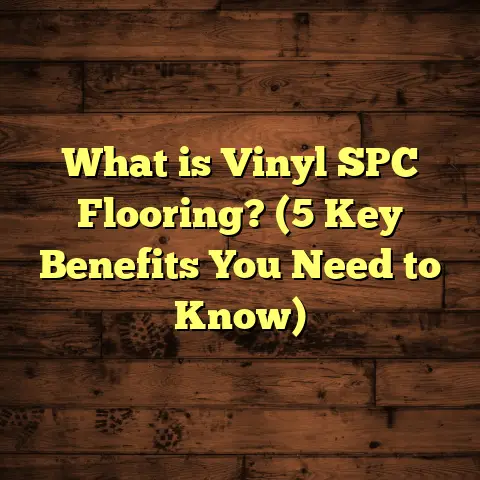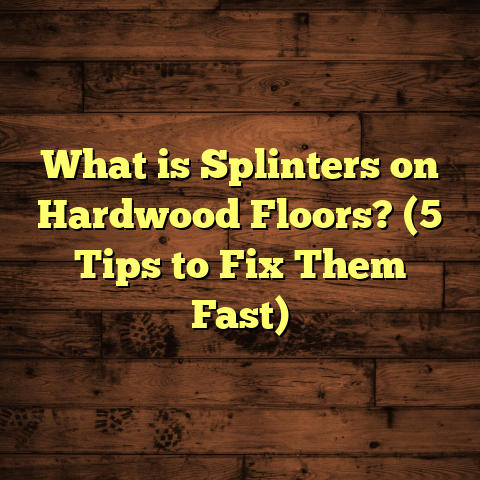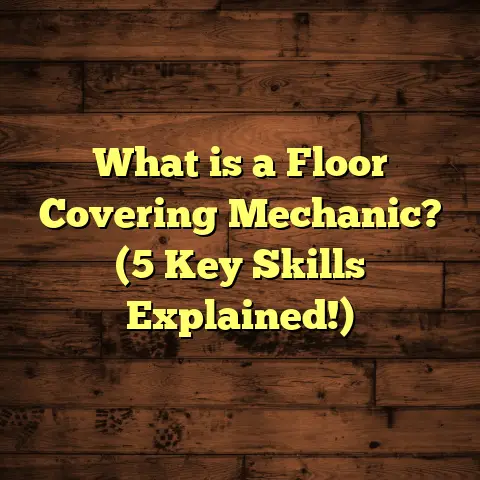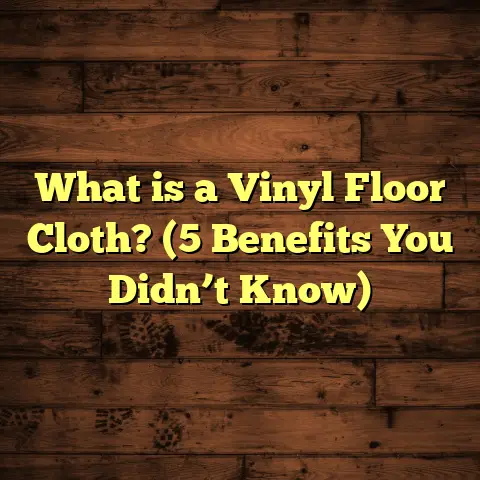What is a Super G Floor? (5 Benefits for Your Space)
I remember when I first heard about Super G flooring during a renovation project several years ago. I was trying to find a floor solution for a client’s high-traffic family room that would be both durable and easy on the eyes. We’d been through hardwood, laminate, vinyl — all good options but they each had their own drawbacks. Then someone mentioned Super G floors. At first, I was skeptical — was it just another flooring fad or something genuinely better? Over time, I decided to dig deeper, and what I found completely changed how I approach flooring projects. If you’re curious about this flooring type and wondering if it could work for your space, I’m going to walk you through everything I’ve learned: from what Super G floors are to why they might be exactly what you need.
What is a Super G Floor?
So what exactly is a Super G floor? You’ve probably heard the name tossed around but might not know what it entails beyond being some kind of “super” floor. The truth is simpler and more practical than marketing hype.
Super G flooring refers to a category of high-performance engineered flooring products that are designed to combine the best qualities of durability, water resistance, style, and ease of maintenance. Unlike traditional hardwood or basic laminate floors that force you to compromise between looks and toughness, Super G floors are built to handle real-life wear and tear while still looking great.
At its core, a Super G floor features multiple engineered layers: a thick protective wear layer on top, a high-resolution decorative layer that mimics natural materials like wood or stone, a sturdy waterproof core (often made from Stone Polymer Composite or Wood Polymer Composite), and a backing layer that stabilizes the entire plank. This layered construction gives the floor strength against scratches, dents, moisture damage, and temperature shifts.
From my experience installing these floors in homes, offices, cafés, and even daycare centers, the biggest appeal is that they don’t just look good temporarily—they maintain their appearance and function even under tough conditions.
Why Should You Care About Super G Floors?
You might be thinking, “Okay, it sounds interesting, but why should I care?” Here’s the thing: flooring is one of the most permanent and costly parts of any interior project. You want something that lasts without turning into a constant headache with repairs or complicated upkeep.
In my early days as a contractor, I saw too many clients frustrated by floors that scratched easily, warped after spills, or needed replacement within just a few years. It’s not just about cost—it’s about peace of mind. Super G floors aim to solve those problems by offering a robust option designed for modern living.
5 Benefits for Your Space
Let me break down five key benefits of Super G floors that matter most for your home or business.
1. Durability That Handles Real Life
One of the biggest challenges with floors is dealing with everyday wear: scratches from moving furniture, pet claws running across the room, dropped keys or kitchenware. Many common flooring materials show damage quickly under these conditions.
Super G floors are engineered with an extra thick wear layer—sometimes 10 times thicker than standard laminates or vinyl—which means they resist scratches and surface damage far better. This isn’t just marketing talk; manufacturers provide data showing their wear layers can withstand over 20,000 cycles in abrasion tests before showing wear marks.
Here’s a story from a commercial project I worked on: A busy café in the city center installed Super G flooring in their dining area. With hundreds of customers every day moving chairs and spilling drinks, they worried about how long their floors would last. After six months of heavy use, the floor looked nearly brand new—no scratches or stains in sight. That saved them thousands in potential repair costs and downtime.
If you have kids or pets at home, you’ll appreciate how well these floors hold up to high traffic without showing damage like other flooring types often do.
2. Water Resistance That Protects Against Spills
Water damage is one of the most common causes of flooring failure. Hardwood swells and warps when exposed to moisture; laminate can peel or bubble; even some vinyl can buckle if water seeps underneath.
Super G floors typically feature waterproof cores made from SPC (Stone Polymer Composite) or WPC (Wood Polymer Composite). These materials don’t absorb water like wood-based products do. Plus, many Super G floors have sealed edges that prevent water from seeping between planks.
This makes them perfect for kitchens, bathrooms, basements, laundry rooms — anywhere where spills or humidity are common concerns.
In my own house renovation project, I installed Super G flooring in the kitchen after dealing repeatedly with water-damaged laminate floors in previous homes. Months later, despite plenty of cooking spills and steam exposure, the floor showed zero signs of swelling or discoloration.
From industry reports, SPC core floors can resist standing water exposure for up to 24 hours without damage—something traditional laminates simply cannot match.
3. Easy Maintenance Lets You Spend Time Living
Who wants to spend hours scrubbing floors or buying special cleaners? One huge plus with Super G floors is how low-maintenance they are.
Thanks to their dense protective wear layer and sealed surface texture, these floors don’t trap dirt or stains easily. Simple sweeping plus occasional damp mopping usually keeps them looking clean. Some models even feature antimicrobial coatings that inhibit bacteria growth—perfect for homes with kids or commercial spaces like daycare centers.
I once installed Super G flooring at a small clinic where hygiene was critical. The staff told me how much easier it was to clean compared to old vinyl floors they’d used before—the antimicrobial surface helped reduce odors and germs without harsh chemicals.
For busy households or businesses wanting great-looking floors without fussing over complicated upkeep routines, this is a big deal.
4. Looks That Impress Without Sacrificing Strength
Some people think durable floors can’t look great. But technology has come a long way.
Super G floors come in an amazing variety of designs—from very realistic wood grains with textured finishes to polished stone looks or even trendy concrete styles. Advances in digital printing and embossing allow manufacturers to create planks that look and feel close to real wood or natural stone.
I’ve had clients tell me they couldn’t believe the difference compared to basic vinyl planks—they loved how natural the flooring looked but were amazed it could survive kids’ spills and pet scratches without staining.
Whether you want classic oak, rustic pine, sleek marble patterns, or something unique like herringbone designs, there’s likely a Super G product that fits your style goals without sacrificing performance.
5. Cost-Effective Over Time
Flooring investments can feel overwhelming initially—especially if you want durable materials that stand the test of time. The good news is that Super G floors offer excellent value when you balance upfront costs with durability and maintenance savings.
While they might cost more than entry-level laminate or vinyl (generally $4-$7 per sq ft versus $2-$4), they’re usually cheaper than solid hardwood ($8-$15+ per sq ft). When factoring in lifespan—often 10+ years for Super G versus 5-7 years for basic laminates—and lower maintenance costs, it adds up.
Here’s a cost comparison from a recent project across 1,000 sq ft:
| Flooring Type | Initial Cost (Materials + Labor) | Estimated Lifespan | Maintenance Cost (5 Years) | Total Cost Over 5 Years |
|---|---|---|---|---|
| Hardwood | $8,000 | 15+ years | $1,200 | $9,200 |
| Basic Laminate | $3,500 | 5-7 years | $800 | $4,300 |
| Super G Flooring | $5,500 | 10+ years | $300 | $5,800 |
The durability reduces replacement frequency and repairs. Plus easy maintenance cuts cleaning time and supplies spent over the years.
How Are Super G Floors Made? A Closer Look Behind the Scenes
Understanding how these floors are built clarifies why they perform so well.
Most Super G planks include:
- Wear Layer: This thick transparent topcoat resists scratches, stains from food or chemicals, and fading from sunlight.
- Decor Layer: Printed images created using advanced digital printing technology replicate natural materials with precise colors and textures.
- Core Layer: Usually SPC (Stone Polymer Composite) or WPC (Wood Polymer Composite). SPC uses limestone powder mixed with PVC for rigidity and waterproofing; WPC adds wood fibers for cushioning but remains water-resistant.
- Backing Layer: Supports stability by preventing plank warping and helps absorb sound for quieter walking.
This multi-layered construction means the floor holds strong against impacts and moisture while staying dimensionally stable in different temperatures—a big upgrade over older laminate options prone to swelling or losing shape.
From my installations around humid climates or cold basements where temperature swings cause issues with normal wood flooring, I’ve seen how Super G holds up better year-round.
Installation Tips From My Experience
Installing Super G flooring isn’t rocket science but requires attention to detail for best results.
- Acclimate Materials: Let planks adjust to room temperature for at least 48 hours before installation.
- Prepare Subfloor: Ensure it’s clean, flat (within 3/16 inch over 10 feet), dry, and free of debris.
- Use Underlayment: Many SPC/WPC products come pre-attached with underlayment but if not, consider adding quality foam underlay for sound absorption.
- Floating Floor Method: Most Super G planks use click-lock systems allowing floating installations without glue—perfect for DIYers.
- Leave Expansion Gap: Leave about 1/4 inch around edges for natural expansion/contraction.
- Avoid Heavy Impact: During installation avoid dropping heavy tools on the planks since extreme force can damage edges.
If you’re uncertain about subfloor condition or want perfect results in tricky rooms like basements or kitchens prone to moisture exposure, hiring professionals is worth considering.
How to Keep Your Super G Floor Looking Its Best
Maintenance is simple but some habits extend life even further:
- Sweep Regularly: Dirt and grit act like sandpaper on any floor surface.
- Damp Mop With Mild Cleaners: Avoid harsh chemicals that might damage protective layers.
- Use Felt Pads Under Furniture Legs: Prevent scratches from moving chairs or tables.
- Wipe Spills Quickly: Even though it’s water resistant, standing liquids longer than necessary isn’t ideal.
- Avoid Sharp Objects: Be mindful when moving heavy equipment or tools across your floor.
I once had a client who neglected simple cleaning routines—after a year her floor lost some shine quicker than expected. After adjusting care habits she noticed immediate improvements.
Common Questions I Get About Super G Floors
Are Super G Floors Environmentally Friendly?
Many brands now offer options made with recycled materials and have low VOC emissions making them safer indoors. Check certifications like FloorScore if indoor air quality matters to you.
Can You Install Super G Floors Over Existing Flooring?
Yes! One advantage is you often don’t need to remove old tile or vinyl if it’s flat and stable enough. This saves demolition mess and labor costs.
How Long Does Installation Take?
For an average-sized room (about 200 sq ft), installation usually takes one to two days including preparation time—much faster than hardwood sanding/finishing projects.
Can They Be Repaired?
Minor scratches can sometimes be buffed out depending on surface coating; damaged planks can be replaced individually thanks to click-lock design—much easier than repairing glued hardwood sections.
Personal Story: From Skeptic to Advocate
When I first encountered Super G flooring on a commercial job site five years ago, I wasn’t sold immediately. It seemed like just another laminate alternative promising durability. But after seeing how well it held up under tough restaurant conditions compared to traditional options—and then testing it in my own home kitchen—I became convinced this was a serious product worth recommending widely.
Since then I’ve installed Super G flooring in dozens of projects ranging from residential basements to office complexes. The consistent feedback? Fewer callbacks for repairs plus happy clients impressed by looks and comfort underfoot.
Final Thoughts
Choosing flooring is one of those decisions that affects everyday life more than most realize—how safe your walk feels; how often you clean; how much wear your floor shows after years of use. If you want something balancing strength with style without constant worry about damage or water issues, Super G floors are hard to beat.
If you’re considering new flooring for your space—whether home or business—think about what matters most: durability? Water resistance? Easy care? Style? Chances are Super G offers a solution fitting all those needs better than many alternatives I’ve worked with over the years.
Feel free to reach out anytime if you want help selecting brands or advice on installation—I love sharing what I’ve learned firsthand working with these innovative floors!





